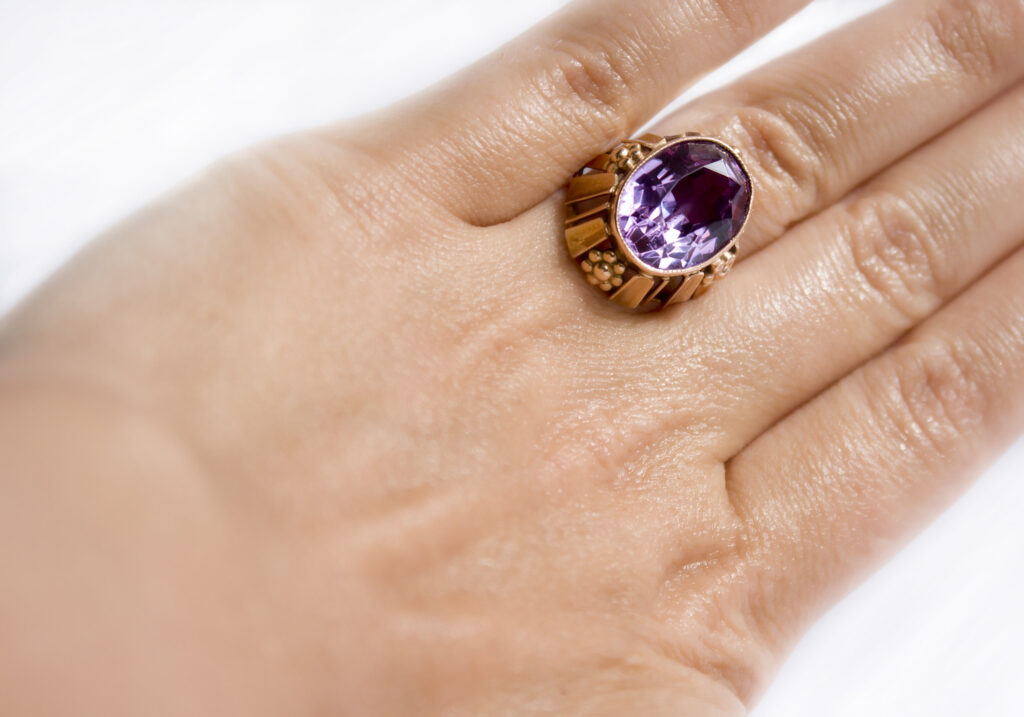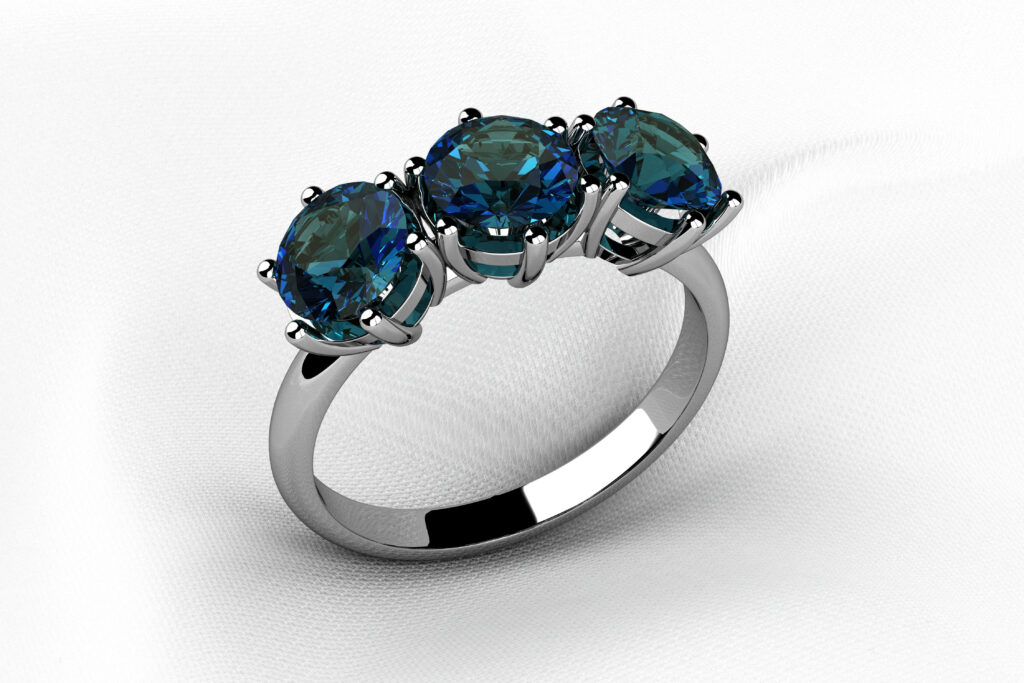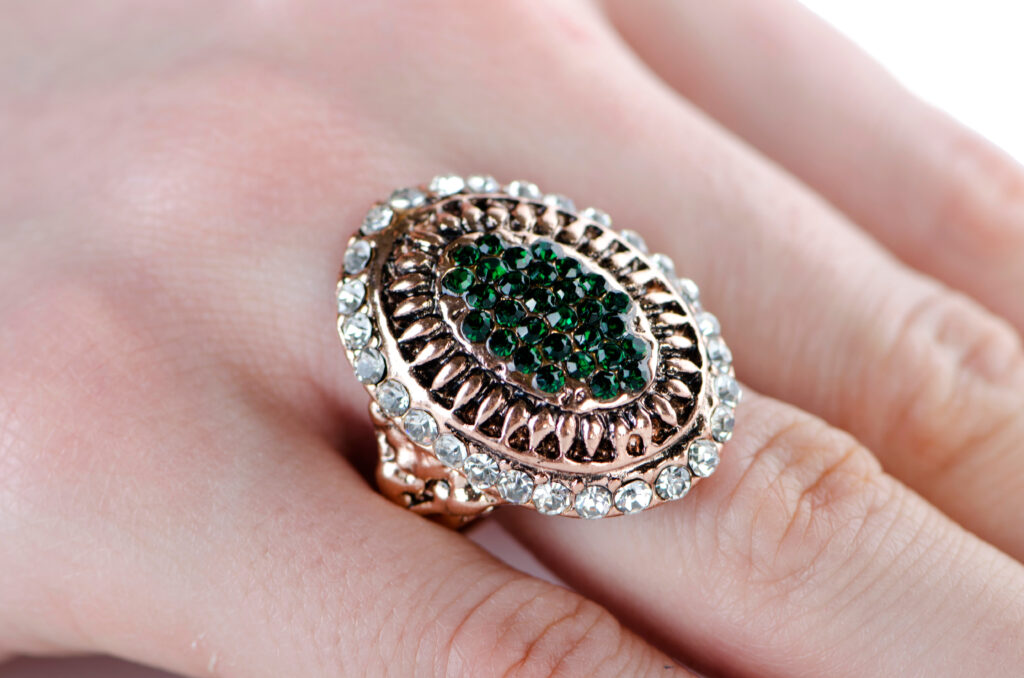
Alexandrite rings are most often stunning eye-catchers and they can make beautiful engagement rings.
However, are there any cons to Alexandrite rings that are important to know? Let’s find out.
Alexandrite is a lovely stone that makes a real statement as an engagement ring. It has a hardness rating of 8.5 on the Moh’s Hardness Scale, making it fairly durable. However, because it is so rare, Alexandrite is growing more expensive. It is also not guaranteed to have a pretty color change.
Want to know more? Below are some buying tips, care tips, and pros and cons about Alexandrite rings.
Read on to see whether Alexandrite is right for you!
Pros and Cons
Obviously, a diamond ring is not the end-all-be-all as far as engagement rings are concerned.
Alexandrite is a unique, durable stone and can make a perfectly nice engagement ring.
However, it does have its strengths and weaknesses. Here are a few you may want to know about.
Pros
As mentioned before, Alexandrite is terribly unique.
Named for the Russian Tsar Alexander II, Alexandrite has a pretty feature that other stones do not: it can change color!
In natural light, it appears as Emerald green.
In artificial/incandescent lighting, it can appear purple or Ruby red.
For this reason, many choose Alexandrite over diamond because who would not want such an eye-catching piece of jewelry?
Additionally, the color changes are not limited to green or red.
There are also variations on brown, pink, purple, orange, dark green, yellow, and many others.
This means there is a ring and a color for everybody out there!
Alexandrite’s capacity and variety are other factors that make it a fairly popular choice.
It is fairly difficult to compete with diamonds as far as hardness and durability are concerned. However, do not dismiss Alexandrite too hastily.
While it could never be quite as tough as a diamond, it does boast a whopping 8.5 on the Mohs Hardness Scale.
This makes Alexandrite a fairly durable choice and perfect for those who are outside-the-box thinkers.
Cons

Before you get too excited, Alexandrite has a few downsides that you probably ought to know about.
While it is a very rare and unique gem with color-changing properties, Alexandrite can also be a bit difficult to get right.
By that, I mean people often favor the bold colors over the plain ones, which can sometimes mean you will not be totally satisfied with your choice of ring.
Unfortunately, if you are looking for a stunning color-changer, that probably means you will have to pay a lot more than you would otherwise.
Purchasing a cheaper Alexandrite ring often means you are going to get stuck with a blander color.
While Alexandrite can be eye-catching, it does not have the sparkle or brilliance of a diamond.
Its brilliance comes from its ability to change color, which, as mentioned before, is not always guaranteed to be pleasing to the eye.
If you want an Alexandrite ring that will make people stop and look, you will definitely have to spend more money.
Many people consider it a dealbreaker if they have to purchase a crazy expensive ring to appreciate its appearance.
Another thing is the price. Diamonds, obviously, do not come cheap, but they are often easier to find.
Due to Alexandrite’s growing rarity, they are becoming harder and harder to find and thus becoming more expensive.
As mentioned above, you will have to spend more money if you want a guaranteed pretty color change.
Definitely prepare to empty your wallet a little bit if you choose to invest in Alexandrite.
Buying Alexandrite: Tips and What to Look For
There are a lot of variables to consider when buying an Alexandrite ring (color, size, shape, metals, etc.).
Here are a few things you might want to be on the lookout for before you buy.
Things to Look For
Firstly, you will want to consider which metals are best paired with Alexandrite.
Obviously, this will vary some depending on the colors/shades of the ring, but generally, it does look pretty nice in yellow gold.
This accentuates red and purple tones as well as the green/cool tones in a ring.
Conversely, if you have a warmer toned ring (yellow, orange, etc.), you may want to lean more toward a white band.
What it really comes down to is your preference of which tone you want to complement most.
The price of Alexandrite rings does vary. It depends greatly on the color and size of the ring.
As mentioned before, you should be able to identify a more expensive ring by the level and boldness of its color.
For example, a bright red or purple Alexandrite ring would be far more expensive than, say, a gray or brown-toned ring.
Red and purple are easily the most expensive types. As a general rule, you should only have to pay a high price for a ring with both a warm and cool tone.
You will want to ensure you are buying a high-quality ring, and that can best be done if you buy from a reliable, professional source.
Your best bet is to buy a certified stone from a reputed laboratory.
This is the easiest way to ensure you are getting an honest deal and not paying more than you ought to for your Alexandrite.
As far as settings are concerned, your best bet is to invest in a ring with a hard metal setting.
This is primarily because Alexandrite is softer than diamond and will need a sturdy mount.
Gem experts say that, if possible, you should stick to purchasing natural gems rather than getting treated or synthetic ones.

Is My Alexandrite Gem Real?
Obviously, nothing is more important than knowing whether or not you are purchasing a real gem.
If you are not concerned about whether it is real or fake, that’s not necessarily a problem, but you will want to know regardless because of the price of the gem.
As mentioned above, buying your ring from a reliable source is incredibly important because if you do not, you run the risk of being swindled out of thousands of dollars.
The quickest way to figure out if your gem is real is to check the color under different lighting.
In natural sunlight, it should turn pure green or bluish-green. Under incandescent light, it should turn pure red or reddish-purple.
You should test the red using old-fashioned lightbulbs rather than the newer kinds.
If it turns properly red, your Alexandrite should be fiery enough to catch attention from across the room.
Additionally, knowing where it came from always helps.
If you know for a fact that your ring came from Russia several years ago (where Alexandrite first became popular), there is a good chance it is a real Alexandrite gem.
It may or may not be impossible to tell on your own. However, if this is the case, feel free to consult a gemologist or jewelry expert.
They will for sure know how to tell you whether or not your gem is real and in turn how valuable it really is.
Cost
Again, the value of an Alexandrite ring is greatly dependent upon the purity of the tones.
If a ring has the capability to change from pure red to pure green, the price will likely be sky-high.
Muddied or diluted/mixed tones hold far less value.
Size can also greatly affect a ring’s cost.
Some Alexandrites can be sold for as little as 1,200 dollars. These are usually the dull-toned or synthetic, lab-grown gems.
As mentioned above, if your budget allows, you should try to stick with natural gems for full value.
Oftentimes you can find Alexandrite rings for cheap (like 1,200 dollars or less).
If you are going the all-natural, genuine gem route, you might find you will be paying as much as 75,000 dollars for a ring.
Usually, some rings are sold for about 15,000 dollars per carat.
You can use that measurement to carefully assess all of your options. Consulting a gem expert can never hurt either!
Caring for Alexandrite Engagement Rings: Dos and Don’ts

Alexandrite is pretty durable as far as most gemstones go, so it will handle maintenance fairly well.
While it does not require any kind of special attention, there are a few dos and don’ts you may want to think about concerning maintenance and general care.
Here are some of the most important ones.
Firstly, it is always a good idea to take out insurance on your ring.
Obviously, losing a ring (especially an Alexandrite wedding ring) is devastating and expensive to replace.
If you purchase insurance, the replacement process will be cheaper and far less painful.
Additionally, you should take care not to take your ring off in public. Doing so increases the chance that you will lose it and never see it again.
Alexandrite is sturdy, but that does not mean it will not get lost or be expensive to replace.
You should also avoid touching the center stone as much as possible.
Again, Alexandrite is sturdy and durable, but oil and dirt on your hands will stick to your gem-like glue.
If you want to keep it from going cloudy and looking as pristine as possible, keep your hands off as much as you can.
Natural Alexandrite will not likely turn cloudy, though artificial gems might.
If your stone is looking cloudy, there is a possibility that something is trapped underneath it and needs to be removed.
Do not take your Alexandrite’s durability for granted. It scores high on the hardness scale, but you should still avoid putting it through needless wear and tear.
It is still susceptible to chipping if it is constantly knocked around on other hard materials.
That said, it might be wise of you to remove your ring when doing something hands-on.
This will keep the ring from being damaged and knocked around unnecessarily.
It might also be prudent of you to invest in some ring bowls to keep around the house.
Storing Alexandrite rings in a pile or a tangle in a drawer is not the best thing you could do.
Alexandrite rings are more than capable of scratching one another and damaging the finish on the ring’s metal.
For this reason, ring bowls and, if possible, storing each jewelry item in its own separate bag/box is a necessary move.
If possible, you should schedule monthly or bi-monthly appointments with your jeweler for cleaning and any necessary repair.
You can clean an Alexandrite ring yourself, but if you would prefer to have more expert hands undertake that task, meeting often with a jeweler is your best bet.
Usually, cleaning should not cost any more than 20 dollars a visit.
If you get your cleanings done at the store where you purchased the ring, you might be able to get the cleaning done for free.

Additionally, if you have invested in a ring with a 14k white gold band, you will definitely want to get it cleaned professionally.
Unfortunately, this stuff scratches really easily so taking it to your jeweler is probably your best bet.
If you would like, your jeweler could rhodium plate it for you. This will make the ring twice as sturdy and less susceptible to scratching.
It will also prevent it from developing a dirty, tarnished look.
In addition to getting your ring cleaned by a jeweler, you should also clean it yourself regularly.
However, take great care to avoid using harsh chemicals on your ring.
Not only could it prove dangerous to you, but using bleach and other harsh cleaning agents could even damage or discolor your ring.
Because they are fairly durable, Alexandrite rings don’t typically require any kind of special cleaning attention.
Of course, you should still exercise caution and care when handling it as even the toughest Alexandrite can shatter under one well-aimed hit.
Using warm water with a few drops of dish detergent should be plenty powerful enough to clean your ring.
You should also be safe to steam clean it or use an ultrasonic bath.

